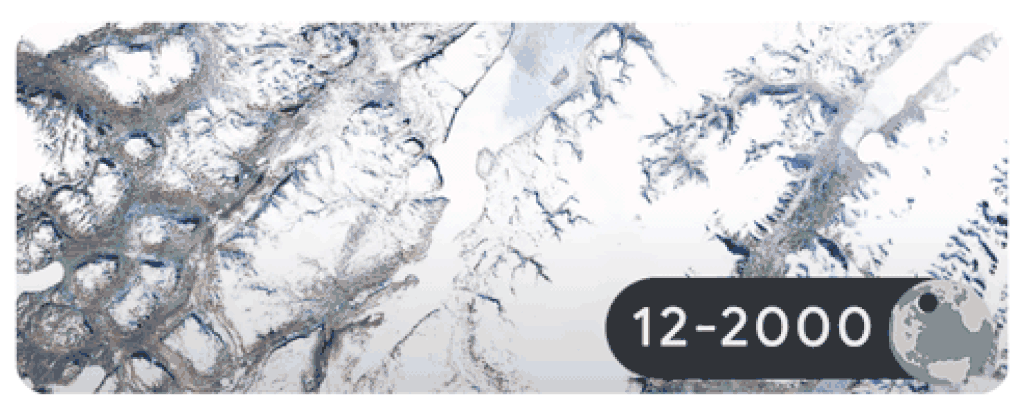Each year on April 22 Google's homepage marks the occasion of Earth Day. Most of the time, these interactive logos are a celebration of our planet and its ecosystems, but this year, after a particularly devastating international climate report, the Google Doodle has taken a stark turn.
In 2018, the Earth Day doodle featured the hopeful work of conservationist Jane Goodall. In 2019, the doodle showcased several awe-inspiring organisms, like the wandering albatross and the coastal redwood.
In 2020, the homepage was abuzz with the pollinating power of bees. And in 2021, Google users were reminded of the intergenerational overstory of trees.
But this year there are no cute characters dancing around on Google's homepage teaching us how to be good stewards of our planet. In fact, there are no illustrations at all.
Instead, users are confronted with the stark reality of our rapidly changing planet.
Using real imagery from Google Earth Timelapse and other sources, today's Earth Day doodle cycles through images of glacier retreat on Mount Kilimanjaro and in Greenland, coral bleaching on Australia's Great Barrier Reef, and a plague of forest destruction in Germany.
Each of these scenes is devastating on its own, and every few hours the focus changes.
The timelapse of glacier retreat on Kilimanjaro was created using annual satellite imagery from 1986 to 2020. By 2030, some estimates suggest this glacier could disappear completely.
 Mount Kilimanjaro images taken each December from 1986 to 2020. (Google Doodle, 2022)
Mount Kilimanjaro images taken each December from 1986 to 2020. (Google Doodle, 2022)
Greenland's glaciers have received more attention in general, as they are retreating at a particularly rapid rate. The timelapse featured on Google's Earth Day doodle spans 2000 to 2020.
The first image shows a landscape covered in ice. The last image features only splotches of white.
 Images from the Greenland ice sheet in Sermersooq each December from 2000 to 2020. (Google Doodle, 2022)
Images from the Greenland ice sheet in Sermersooq each December from 2000 to 2020. (Google Doodle, 2022)
In warmer locales, like the Great Barrier Reef, a landscape of white is the new normal, and it's not a good thing at all; bleaching events in 2016 destroyed more than 75 percent of Lizard island's colorful coral. The timelapse breaks down that year's destruction month to month, from March to May on a single patch of reef.
 Images of coral bleaching on Lizard Island, Australia, taken each month from March to May, 2016. (Google Doodle, 2022)
Images of coral bleaching on Lizard Island, Australia, taken each month from March to May, 2016. (Google Doodle, 2022)
The final timelapse depicts forest dieback in the Harz region of Germany. The death of this forest's spruce trees is largely being driven by rising temperatures and severe drought, which makes the trees particularly susceptible to outbreaks of bark beetles. From 2001 to 2020, Harz forests have lost 30 percent of their coverage.
From 1995 to 2020, the Google timelapse shows the forest going from a vast swathe of green to a largely dull brown background.
 Images of Germany's Harz forests taken each December from 1995 to 2020. (Google Doodle, 2022)
Images of Germany's Harz forests taken each December from 1995 to 2020. (Google Doodle, 2022)
It's easy to feel hopeless looking at these images, but it's also an important reminder that time for climate action is running short. The point of Earth Day is to remind us of our role as stewards of the environment, and this year is all about "investing in our planet".
"We need to act (boldly), innovate (broadly), and implement (equitably). It's going to take all of us. All in. Businesses, governments, and citizens – everyone accounted for, and everyone accountable. A partnership for the planet," reads the Earth Day website.
"And while there is still time to solve the climate crisis, time to choose BOTH a prosperous and sustainable future, and time to restore nature and build a healthy planet for our children and their children, time is short."
Today's Google Doodle serves to drive that message home. No matter what you search on this Earth Day, you won't be able to escape our planet's grim reality.
Earth Day lists 52 ways we all can invest in our planet here.
